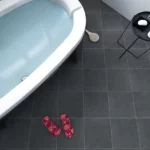Tile is known for its water resistance and easy cleaning. With the right maintenance routine, your tile floors, walls, and countertops will look
great and last for years.
Basic Maintenance
Sweep or vacuum floors to remove any dust or debris before using any cleaning products. Damp-mop your tile floor at least once each week
(more frequently for heavy traffic areas) to decrease wear and abrasion from grit and soil.
Glazed Tile
Clean regularly with an all-purpose, non-oil-based household cleaner that’s compatible with cleaning grout joints. Use an everyday
multipurpose spray cleaner to remove soap scum, hard water deposits, and mildew on wall tiles in your bath or shower.
Unglazed Tile
Use concentrated tile cleaners that have a neutral pH for regular cleaning. These will safely remove grease, oils, and normal spills—just
check to be sure the cleaner is intended for the application, use, and traffic level. Clean glass tile with any nonabrasive cleaner recommended
for either glass or tile.
Tips for Preventing Damage
Test scouring powders and sealants on a small area before cleaning the full area.
Use a sealer on grout joints shortly after installation and use products compatible with cleaning grout joints.
After cleaning, rinse the entire area with clear water to remove any cleaning solution residue.
Have any damaged or broken tile removed and replaced only by a qualified tile contractor.
Extra Protection
Invest in high-quality floor mats and protective pads under heavy furniture for an extra layer of protection to your tile floors. Place floor mats
at entrances and exits—they collect and trap corrosive substances that can be tracked in, like dirt, sand, oil, grit, asphalt, or even driveway
sealer. Placing mats in high-traffic areas—in front of vanities, kitchen sinks, and stoves—is an effective way to reduce tile wear.
What to Avoid
Any cleaners containing acid or bleach shouldn’t be used for routine maintenance.
Avoid wax-based cleaners and oil-based detergents, and use sealants on grout joints only.
Harsh cleaning aids like steel wool pads or any scouring pads containing metal shouldn’t be used on tile.
Unglazed tile should not be cleaned with an agent that contains color.
How to Clean Wall Tiles
With the grout back to brand spanking new, give your tiles some love. Consider the finish of your wall tiles before you start. For example,
for plain ceramic tiles, a scouring pad should be ok. However, for printed pattern tiles, it might be safer to use a soft sponge or microfiber
cloth. Never use vinegar or harsh cloths on marble!
If you can, run some hot water over or near the tiles to open up the ceramic pores and really get deep into the dirt.
Choose the right cleaner for your wall tiles, depending on their material. A gentle stonewash cleaner is suitable for travertine, limestone,
granite, sandstone, slate, marble and polished porcelain.
For heavy duty grime, you might need something a little stronger to remove stains like oil, grease and any ingrained dirt.
How to Clean Grout
We all know how quickly dirty grout that’s supposed to be white can transform the look of a room. So cleaning your grout is the best place
to start – and a quick win to give you some big cleaning satisfaction.
The best way to tackle grout and remove built-up grime is to use an old toothbrush as your weapon of choice.
For mild stains, a nifty trick is to mix some baking soda with vinegar to form a paste. Get involved and get scrubbing with a dollop of elbow
grease, using your toothbrush to work the paste in between the tiles. Leave it for 30 minutes before you rinse off.
For dirtier, stubborner stains, use a grout stain remover or grout cleaner that’s safe for your tiles. Make sure you test the cleaner in an area
not visible first.
How to Clean Tile Floors
As there’s often a larger surface to cover with floor tiles, sometimes it’s easier to just break out the steam cleaner! Although an appealing
option, it’s not always suitable for certain tiles so check first to avoid any risk of scratching your tiles.
For longevity of your floors, use the correct maintenance cleaner to increase the life of the protective seal. Meaning these deep cleans don’t
become a regular chore!
Be careful using normal detergents, we’d even say avoid it. On sealed surfaces, normal cleaning products and strong bleach will remove the
protective seal.











